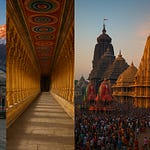Shardiya Navratri is one of the most significant Hindu festivals, celebrated over nine days to honor the nine forms of Maa Durga, known as Navadurga. Each day is dedicated to one form of the Divine Mother and carries deep spiritual meaning.
The first day of Navratri, falling on 22nd September 2025, is devoted to Maa Shailputri, who symbolizes new beginnings, purity, strength, and devotion. Worshipping her is believed to lay the spiritual foundation for the rest of the festival.
Who is Maa Shailputri?
The name Shailputri translates to "Daughter of the Mountain" (Shail = mountain, Putri = daughter). She is the first form of Maa Durga.
Depiction of Maa Shailputri:
She rides on a bull, Nandi, which represents purity and determination.
She carries a trident (Trishul) in her right hand, symbolizing courage and divine power.
She holds a lotus in her left hand, representing peace and devotion.
Maa Shailputri is also known as Parvati, Hemavati, and Sati. She is the consort of Lord Shiva and is believed to be the goddess who governs the Muladhara Chakra (Root Chakra), which is the base of spiritual discipline.
Mythological Story and History
In her previous birth, she was Sati, the daughter of King Daksha and the wife of Lord Shiva. When King Daksha insulted Shiva during a Yagna, Sati, unable to bear the disrespect, immolated herself in the sacrificial fire.
In her next birth, she was reborn as Parvati, daughter of King Himavan, ruler of the Himalayas, and thus came to be called Shailputri. With great penance and devotion, she reunited with Lord Shiva. Her story emphasizes devotion, sacrifice, and the power of perseverance.
Religious Importance
The worship of Maa Shailputri is considered essential because:
She purifies the devotee’s life and helps in erasing past sins.
She provides patience, stability, and strength.
She ensures family harmony, marital bliss, and blessings for a good life.
She governs the Root Chakra, bringing spiritual balance and grounding energy.
Farmers in several regions also worship her on this day for blessings of a good harvest.
Rituals and How to Worship Maa Shailputri
Ghatasthapana (Kalash Sthapana)
The very first ritual of Navratri is Kalash Sthapana:
A clay pot is prepared with soil in which barley or wheat seeds are sown.
A Kalash (sacred pot) is filled with water and topped with mango leaves and a coconut.
The Kalash is placed for nine days as a symbol of energy, creation, and prosperity.
Invocation of Maa Shailputri
Red flowers, a red chunri, sandalwood paste, incense sticks, and a ghee lamp are offered.
Pure ghee is offered as bhog, believed to ensure good health and longevity.
Mantras to Chant
Beej Mantra:
"ॐ एं ह्रीं क्लीं चामुण्डायै विच्चे ॐ देवी शैलपुत्र्यै नमः"
(Om Aim Hreem Kleem Chamundayai Vichche Om Devi Shailputryai Namah)Dhyana Mantra:
वन्दे वाञ्छितलाभाय चन्द्रार्धकृतशेखराम् ।
वृषारूढ़ां शूलधरां शैलपुत्रीं यशस्विनीम् ॥
Aarti
The traditional Durga Aarti, "Jai Ambe Gauri," is performed with devotion while lighting lamps and offering flowers.
Bhajans
Devotional songs and bhajans dedicated to Maa Shailputri are sung or played to invite her blessings.
Do’s on Day 1
Begin the day with a bath and wear clean clothes in red or orange shades.
Light a ghee lamp and place it before Maa Durga.
Chant mantras, perform aarti, and read chapters from the Durga Saptashati.
Observe fast by consuming fruits, milk, and sattvic food.
Donate red cloth, rice, or milk to the needy.
Don’ts on Day 1
Avoid consuming alcohol, meat, onion, and garlic.
Do not use harsh words or negative speech.
Avoid wearing black clothes.
Do not leave the Kalash unattended or impure.
Food to Eat During the Vrat
Allowed foods: Fruits, milk, curd, dry fruits, sabudana khichdi, kuttu puri, singhara atta halwa, aloo jeera, and samak rice.
Bhog for Maa: Ghee, milk, and sweets made of milk such as kheer or peda.
Avoided foods: Onion, garlic, rice, pulses, non-vegetarian food, and alcohol.
Clothing and Colors
The color of the day is Orange or Red.
Women usually wear sarees, suits, or chunri in these colors.
Men may wear saffron, white, or orange attire.
Types of Pujas Performed
Shodashopachara Puja (16-step ritual worship).
Recitation of Durga Saptashati.
Chandi Path for protection and blessings.
Kumari Puja, in which young girls are worshipped as the embodiment of Maa Durga.
Spiritual Significance
Maa Shailputri governs the Root Chakra (Muladhara). This chakra is the base of spiritual discipline, stability, and balance. Worshipping her helps strengthen inner grounding, self-confidence, and focus.
Regional Celebrations
In North India, Navratri begins with Kalash Sthapana and fasting.
In West Bengal, Mahalaya and recitation of Mahishasura Mardini marks the arrival of Devi Paksha.
In South India, the festival of Golu (doll display) begins.
In Nepal, this day is known as Ghatasthapana, starting the Dashain festival.
On 22nd September 2025, the first day of Navratri, devotees will worship Maa Shailputri, the daughter of the Himalayas and the first form of Maa Durga. Her worship symbolizes strength, patience, and devotion, setting the spiritual tone for the rest of Navratri.
May Maa Shailputri bless all devotees with stability, courage, health, and prosperity this Na











